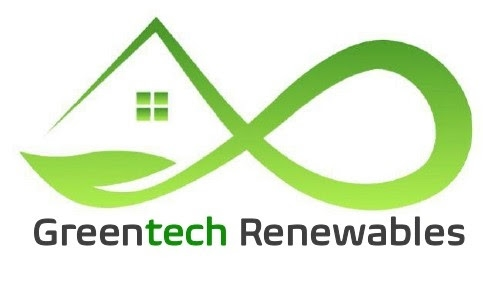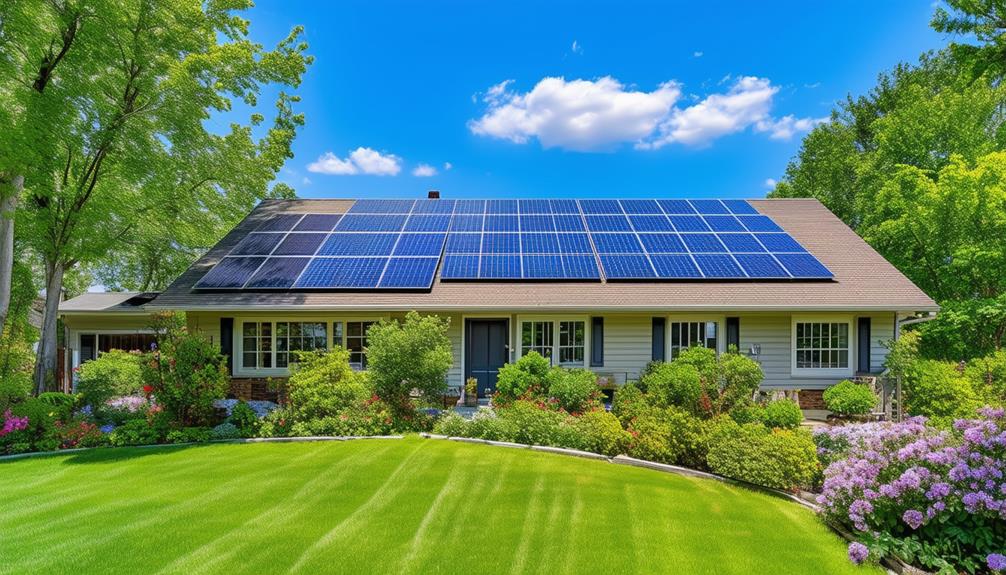Benefits of Investing in Solar Panels
Investing in solar panels for your home offers several benefits, including reduced electricity bills, a lower carbon footprint, and financial incentives. High-efficiency panels, with 15% to 24% efficiency, can cover up to 117% of an average home’s electricity demand. The installation cost for a typical 4kW system ranges from £5,000 to £6,000, with a payback period as short as 8 years. Quality suppliers like Greentech Renewables ensure smooth installation and optimal system performance. Battery storage further enhances energy independence and savings. Various grants and 0% VAT on energy-saving materials make it a worthwhile long-term investment. Explore the next steps to understand its full advantages.
Investment and Efficiency
Investment and Efficiency: When considering solar panels for your home, understanding both the investment costs and the efficiency benefits they offer is essential. In the UK, solar panels can cover up to 117% of an average home’s electricity demand under ideal conditions, making them an effective solution for energy independence. High-efficiency solar panels typically range from 15% to 24% efficiency, which is crucial for maximizing output, especially with limited roof space.
One significant advantage of installing solar panels is the potential savings. Over 25 years, you could save up to £16,500 on electricity bills, making the initial investment worthwhile due to long-term financial benefits. Additionally, UK weather conditions, often perceived as a drawback, actually aid in maintaining panel efficiency. Rainwater helps to naturally clean the panels, ensuring they operate optimally most of the year.
Most domestic solar panels have a lifespan of 25 to 30 years, offering long-term energy savings and contributing to environmental sustainability. This extended lifespan ensures a reliable source of energy for decades, enhancing their investment appeal.
Costs and Grants
Costs and Grants: Installing solar panels for your home involves upfront costs, but various grants and incentives can reduce the financial burden. A domestic solar panel system in the UK costs between £5,000 and £6,000 for a 4kW setup. This initial expenditure might seem significant, but the potential payback period can be as short as 8 years.
Several grant schemes are available to ease the financial impact. The UK offers 0% VAT on energy-saving materials, including solar panels. Additionally, the Smart Export Guarantee (SEG) allows you to earn money by exporting surplus energy back to the grid. For lower-income households, the Energy Company Obligation Scheme provides further assistance.
Choosing a Supplier
Choosing a Supplier: After understanding the costs and potential grants, your next step is to choose a reliable solar panel supplier to ensure a smooth installation process. Selecting the right supplier is critical for optimizing your home’s energy efficiency, contributing to environmental conservation, and maximizing financial savings.
To make an informed decision, consider these key factors:
- Experience and Certifications: Choose suppliers with extensive experience and necessary qualifications. This ensures they meet industry standards and have a proven track record of successful installations.
- Customer Reviews and Ratings: Research customer feedback and ratings to evaluate the reliability and quality of the supplier’s service. Positive comments from previous clients indicate a trustworthy and competent provider.
- Financial Options and Savings: Check if the supplier offers finance options, which can help manage the installation costs more effectively. A good supplier will also assist in maximizing your savings and potential earnings from surplus energy generation.
Utilizing services like Greentech Renewables can connect you with up to four professional installers for quick comparison of quotes, helping you find the best deal. A reputable supplier with solid credentials ensures a seamless installation process and long-term benefits for your home.
System Specifications
System Specifications: Understanding system specifications is crucial for ensuring your solar panel installation meets your household’s energy needs and maximizes efficiency. Common residential solar panel system sizes range from 1kW to 5kW, catering to different energy demands. The appropriate system size for your home depends on daily electricity consumption, available roof space, and average sunlight hours in your location. Evaluating these factors determines the number of panels required to generate sufficient power.
When considering system specifications, evaluate your roof’s capacity to support solar panels. The available space directly influences the system size. Additionally, understanding your household’s daily energy usage allows you to select a system that meets your specific needs, ensuring optimal performance and energy savings.
Moreover, average sunlight hours in your area significantly impact the system’s efficiency. Locations with higher sunlight exposure can generate more electricity, potentially reducing the number of panels needed. By analyzing these specifications, you can make informed decisions that enhance the effectiveness of your residential solar panel installation.
Installation Process
Installation Process: The installation of solar panels involves mounting them on the roof, connecting them to an inverter, and setting up a monitoring system to ensure optimal performance. This step-by-step process ensures the solar energy system operates efficiently.
Before installation, professional installers assess several factors to determine the number of panels required:
- Roof Space: Evaluate the available roof area to ensure it can accommodate the panels without obstruction.
- Daily Energy Consumption: Calculate household energy usage to determine the appropriate system size, typically ranging from 1kW to 5kW.
- Sunlight Hours: Analyze the average daily sunlight your location receives to optimize panel placement and maximize energy production.
Installation is usually completed in one day. Installers mount the panels securely on your roof, ensuring they’re positioned for optimal sunlight exposure. Next, they connect the panels to an inverter, which converts solar energy into electricity for your home.
Pros and Cons
Pros and Cons: Having learned about the installation process, it’s important to weigh the pros and cons of installing solar panels at home. The primary advantage is the potential for reduced electricity bills, as generating your own power decreases dependence on traditional energy sources. Additionally, you can earn through the Smart Export Guarantee (SEG) by selling surplus electricity back to the grid. Another key benefit is the reduction in your home’s carbon footprint, promoting environmental sustainability.
Financial Incentives: Financial incentives also make solar panels appealing. For instance, you can benefit from a 0% VAT on energy-saving materials, contributing to long-term savings over the system’s 25+ year lifespan. Moreover, solar panels require minimal maintenance, with only occasional professional inspections necessary to maintain efficiency.
Drawbacks: However, there are drawbacks. Initial costs for purchasing and installing solar panels can be high, although these are often offset by long-term savings. Your home’s suitability—such as roof orientation and shading—plays a vital role in the efficiency of solar panels. Ensuring proper placement and adherence to local regulations is essential to maximize benefits.
Battery Storage
Battery Storage: Battery storage systems enhance home solar panel setups by storing excess energy for later use. This maximizes self-consumption and reduces grid reliance significantly. A typical battery storage system retains between 8 to 14 kWh of electricity, providing backup power during outages or nighttime when solar panels aren’t generating energy.
Key Benefits of Battery Storage:
- Increased Energy Independence: Stores excess energy for use when solar generation isn’t possible, reducing grid reliance.
- Backup Power: Provides reliable power during outages, enhancing home safety and convenience.
- Efficiency and Optimization: Smart systems manage energy use effectively, maximizing stored solar power utilization.
Investing in battery storage increases energy independence and efficiency, optimizing your solar panel investment further. Most systems use lithium-ion batteries known for high energy density and long lifespan. Integrating smart energy management systems ensures efficient storage and utilization of solar energy.
Financial Incentives
Financial Incentives: Financial incentives make installing solar panels more affordable and appealing by offering grants, tax benefits, and rebates. These incentives reduce the upfront costs associated with solar panel installations, making renewable energy accessible to a broader audience. Governments and institutions provide various financial schemes to encourage homeowners to shift to solar energy. By leveraging these incentives, you can offset a substantial portion of the initial investment.
Common Financial Incentives:
| Incentive Type | Description | Benefit to Homeowner |
|---|---|---|
| Grants | Direct financial assistance for installation | Reduces overall cost immediately |
| Tax Benefits | Deductions or credits on annual taxes | Lowers taxable income, increasing savings |
| Rebates | Partial refund after purchase and installation | Provides cash back, decreasing net expense |
Additionally, various loan programs and renewable energy certificates can further ease the financial burden. It’s vital to research local and federal programs, as availability and benefits can vary widely. Innovations in solar technology, such as bifacial and thin-film panels, combined with tracking systems, can also improve efficiency, maximizing your return on investment. By understanding and utilizing these financial incentives, you can make a more informed decision about investing in solar panels for your home.


